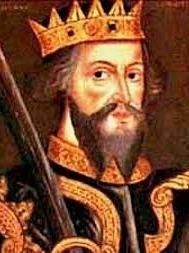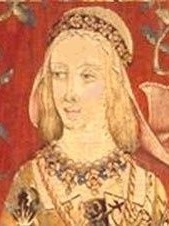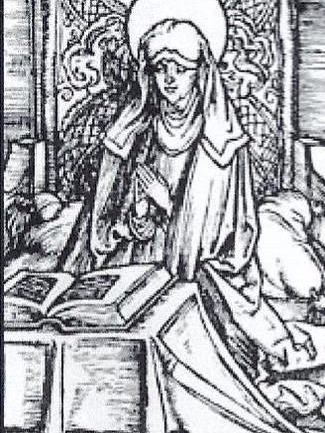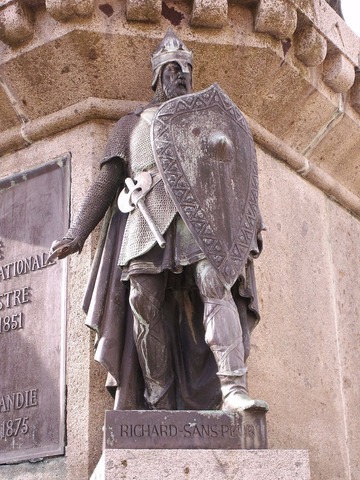Stamboom Snelder - Versteegh » Chieftain William I "Longsword" (William I "Longsword") of Normandy (893-942)
Persoonlijke gegevens Chieftain William I "Longsword" (William I "Longsword") of Normandy
Bron 1- Roepnaam William I "Longsword".
- Hij is geboren op 30 juli 893 in Rouen, Seine-Maritime, Haute-Normandie, France.
- Hij is overleden op 17 december 942 in Picquigny Island, Somme, Picardie, France, hij was toen 49 jaar oud.
- Een kind van Rollo of Normandy en Poppa of Bayeux
Gezin van Chieftain William I "Longsword" (William I "Longsword") of Normandy
Hij is getrouwd met Sprota.
Zij zijn getrouwd
Kind(eren):
Notities over Chieftain William I "Longsword" (William I "Longsword") of Normandy
https://en.wikipedia.org/wiki/William_I_Longsword
William Longsword (French: Guillaume Longue-Épée, Latin: Willermus Longa Spata, Old Norse: Vilhjálmr Langaspjót), (c. 893 – 17 December 942) was the second ruler of Normandy, from 927 until his assassination in 942.[1]
He is sometimes anachronistically dubbed "Duke of Normandy", even though the title duke (dux) did not come into common usage until the 11th century.[2] Longsword was known at the time by the title Count (Latin comes) of Rouen.[3][4] Flodoard—always detailed about titles—consistently referred to both Rollo and his son William as principes (chieftains) of the Norse.[5]
William Longsword was born "overseas"[a][6] to the Viking Rollo (while he was still a pagan) and his Christian wife Poppa of Bayeux.[7][8] Dudo of Saint-Quentin in his panegyric of the Norman dukes describes Poppa as the daughter of a Count Beranger, the dominant prince of that region.[9] In the 11th century Annales Rouennaises (Annals of Rouen), she is called the daughter of Guy, Count of Senlis,[10] otherwise unknown to history.[b] Despite the uncertainty of her parentage she was undoubtedly a member of the Frankish aristocracy.[11] According to the Longsword's planctus, he was baptized a Christian probably at the same time as his father,[12] which Orderic Vitalis stated was in 912, by Franco, Archbishop of Rouen.[13]
Longsword succeeded Rollo (who would continue to live for about another 5 years) in 927[14] and, early in his reign, faced a rebellion from Normans[15] who felt he had become too Gallicised and too soft.[16] According to Orderic Vitalis, the leader was Riouf of Evreux,[16][17][18] who was besieging Longsword in Rouen. Sallying forth, Longsword won a decisive battle, proving his authority to be Duke.[19]:25-6 At the time of this 933 rebellion Longsword sent his pregnant wife by custom, Sprota, to Fécamp where their son Richard was born.[20]
In 933 Longsword recognized ;Raoul as King of Western Francia, who was struggling to assert his authority in Northern France. In turn Raoul gave him lordship over much of the lands of the Bretons including Avranches, the Cotentin Peninsula and the Channel Islands.[21][22][23]:lii The Bretons did not agree to these changes and resistance to the Normans was led by Alan Wrybeard, Duke of Brittany and Count Berenger of Rennes but ended shortly with great slaughter and Breton castles being razed to the ground.[19]:24 Alan fleeing to England and Beranger seeking reconciliation.[24]
In 935, Longsword married Luitgarde,[1] daughter of Count Herbert II of Vermandois whose dowry gave him the lands of Longueville, Coudres and Illiers l'Eveque.[18] Longsword also contracted a marriage between his sister Adela (Gerloc was her Norse name) and William, Count of Poitou with the approval of Hugh the Great.[25] In addition to supporting King Raoul, he was now a loyal ally of his father-in-law, Herbert II, both of whom his father Rollo had opposed.[26] In January 936 King Raoul died and the 16 year old Louis IV, who was living in exile in England, was persuaded by a promise of loyalty by Longsword, to return and became King. The Bretons returned to recover the lands taken by the Normans, resulting in fighting in the expanded Norman lands.[23]:lii
The new King was not capable of controlling his Barons and after Longsword's brother in law, Herluin II, Count of Montreuil, was attacked by Flanders, Longsword went to their assistance in 939,[19]:28-9 Arnulf I, Count of Flanders retaliated by attacking Normandy. Arnulf captured the castle of Montreuil-sur-Mer expelling Herluin. Herluin and Longsword cooperated to retake the castle.[27][28] Longsword was excommunicated for his actions in attacking and destroying several estates belonging to Arnulf.[29]
Longsword pledged his loyalty to King Louis IV when they met in 940 and, in return, he was confirmed in lands that had been given to his father, Rollo.[30] [23]:liii In 941 a peace treaty was signed between the Bretons and Normans, brokered in Rouen by King Louis IV which limited the Norman expansion into Breton lands.[23]:liii The following year, on 17 December 942 at Picquigny on an island on the Somme, Longsword was ambushed and killed by followers of Arnulf while at a peace conference to settle their differences.[18][28] Longsword's son, Richard becoming the next Duke of Normandy.
Longsword had no children with his wife Luitgarde.[31] He fathered his son, Richard the Fearless, with Sprota [c] who was a Breton captive and his concubine.[32] Richard, then aged 10, succeeded him as Duke of Normandy in December 942.[31]
Tijdbalk Chieftain William I "Longsword" (William I "Longsword") of Normandy
 grootouders
grootouders
 ouders
ouders
 broers/zussen
broers/zussen
 kinderen
kinderen
Voorouders (en nakomelingen) van William I "Longsword" of Normandy
William I "Longsword" of Normandy 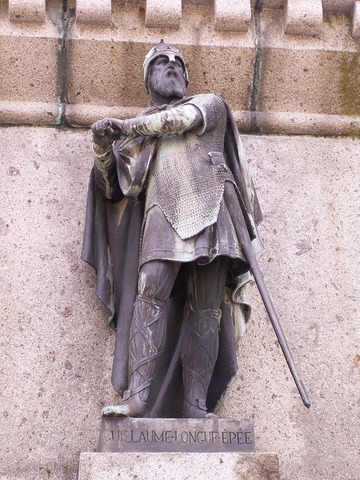 | ||||||||||||||||||||||||||||||||||
Sprota | ||||||||||||||||||||||||||||||||||
Verwantschap Chieftain William I "Longsword" (William I "Longsword") of Normandy
- William I "Longsword" of Normandy is de achter(x42)kleinzoon van Titus Manlius Imperiosus Torquatus:Titus Manlius Imperiosus TorquatusTitus Manlius TorquatusTitus Manlius TorquatusAulus Manlius TorquatusTitus Manlius TorquatusDecimus Junius Silanus ManlianusMarcus Junius Silanus consulMarcus Junius SilanusMarcus Junius Silanus consulMarcus Junius SilanusJunia Calvina EquitusGaius SallustiusGaius Ummidius Quadratus SallustiusGaius Ummidius Quadratus Annianus VerusGaius Ummidius Quadratus Annianus Verus FulviusUmmidia Commificia AntoniaPendania Pedanius FuscusMariana MinorAurelia PompeianaClaudiaConstantius I Chlorus of RomeUnkownProcopius UsurperProcopiusProcopius II Magister Militum of ByzantiumProcopius Anthemius I of the of the Western Roman EmpireAlypia Princess of the of RomeCaratene Agrippina of NarbonneClothilde of BurgundyChlothar I of the FranksCharibert I of ParisCharibert of HesbayeChrodbert I of NeustriaLambert of HesbayeChrodbert II of HesbayeLambert of HesbayeRobert I of NeustriaCancor of HesbayeHeimrich of Upper RheingauUnknown of GrabfeldPoppa I of GrabfeldHenry of the FranksBerengar II of NeustriaPoppa of BayeuxWilliam I "Longsword" of Normandy
Bronnen
- WikiTree, via https://www.myheritage.nl/research/colle...
Guillaume William I 2nd Duke of NormandyGeslacht: ManGeboorte: 30 jul 893 - Rouen, Seine-Maritime, Haute-Normandie, FranceHuwelijk: Ongeveer 932 - Normandel, Orne, Basse-Normandie, FranceOverlijden: 17 dec 942 - Picquigny Island, Somme, Picardie, France,Vader: Rollo I Hrolf Rognvaldsson Duke of NormandyMoeder: Poppa de Bayeux de Senlis de Valois of NormandyEchtgenote: Queen Adela Sprota de Senlis de Bretagne of NormandyKind: Richard I, 'The Fearless', 3rd Duke of Normandy
www.wikitree.com
Aanknopingspunten in andere publicaties
Deze persoon komt ook voor in de publicatie:Over de familienaam Of Normandy
- Bekijk de informatie die Genealogie Online heeft over de familienaam Of Normandy.
- Bekijk de informatie die Open Archieven heeft over Of Normandy.
- Bekijk in het Wie (onder)zoekt wie? register wie de familienaam Of Normandy (onder)zoekt.
Roel Snelder, "Stamboom Snelder - Versteegh", database, Genealogie Online (https://www.genealogieonline.nl/stamboom-snelder-versteegh/I505307.php : benaderd 2 mei 2024), "Chieftain William I "Longsword" (William I "Longsword") of Normandy (893-942)".
